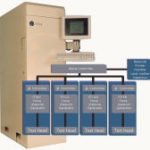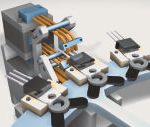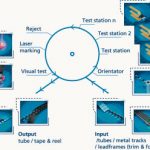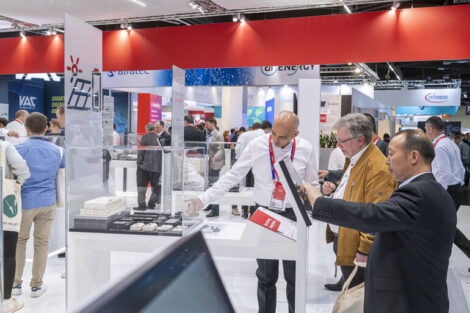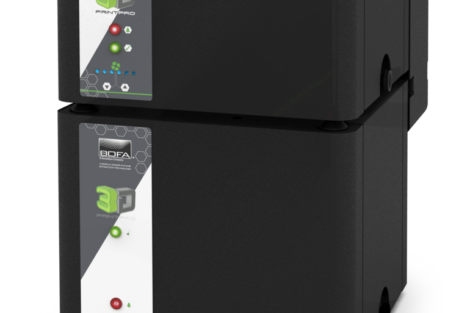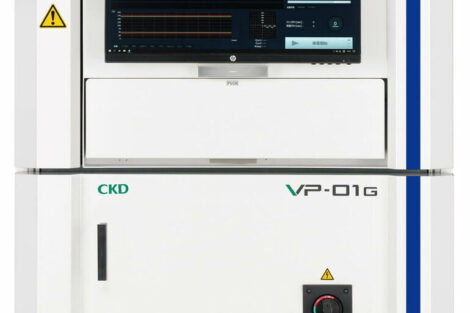Power devices are critical to the success of virtually any electronic product. However, all too often their role is over-shadowed by the eye-catching attention given to seemingly more exciting parts suchas mega-transistor microprocessors, ultra-dense memories and so forth. In fact, the eventual breakdown of a power device can flatten product quality more seriously than an undetected flaw, causing a side effect in one of the ”glitzy” components.
Richard Denyer, ipTEST and Remy Degen, Ismeca
The continuing evolution in electronics miniaturization is driving escalating requirements for millions of highly reliable power devices. It promptly becomes apparent that complete testing of these components is a vital factor for product reliability. At the same time, power devices are also becoming more complicated, as an answer to higher system requirements for different voltage levels, higher current capacities, lower operating temperatures, sophisticated control functions, etc. In most cases this means that power devices can require a broad range of examination parameters, as well as the need for both static and dynamic tests, which can result in longer overall verification times and more difficult (analog) challenges than for many of their purely digital counterparts.
As a result, manufacturers of components such as MOSFETs, bipolar transistors, diodes, insulated-gate bipolar transistors (IGBTs), power rectifiers or thyristors, are often caught at a very difficult intersection – facing tough requirements to maintain high quality in the face of both complex test challenges and escalating production volumes. In addition, the demand to accommodate a widening range of types of discrete power devices also makes it necessary to have test equipment that can be readily adapted for high-mix production environments. It has now become quite clear that a conventional monolithic single-station tester approach can no longer keep up with the high-throughput demands, nor does it provide the flexibility needed to process modern power devices.
Jointly developed by Ismeca and ipTEST is a system that combines a highly efficient rotary-turret, multi-station handling platform with high-speed, static and dynamic test capabilities, to simultaneously conduct stringent verification on multiple parts in parallel. By efficiently blending multiple handling and power test functions within a single platform, the Power 12K system is able to integrate the entire backend process for such devices, while providing throughput rates as high as 12,000 units per hour (UPH), maximizing test flexibility, minimizing setup times and optimizing floor-space utilization.
Parallel operations within a rotary-turret design
The key to this approach is the use of indexed parallel operations that allow the system to efficiently perform a number of different functions at the same time. Building upon Ismeca’s pioneering development of rotary-turret handling techniques, the system is based around the proven NT16 architecture that allows for up to 16 separate stations within a compact rotary-sequencing design. Extensive experience on the shop floor has shown the rotary-turret architecture to be the most efficient approach to sequencing multiple operations for handling any type of components. Because all of the action „revolves around“ a single core with active processing occurring at every station, the rotary turret eliminates inefficient transfer times and wasted motion actions.
The core platform’s inherently small footprint of 1.7 x 2.4m enables multiple power-test stations to be tightly integrated along with other backend functions (such as laser marking, inspection, etc.) and to fit smoothly into existing production floor layouts. The backend handling and test platform can be fed from tube input or, if required, can be interfaced directly to trim-and-form equipment.
Multi-function test capabilities
In optimizing the system function and application, the engineering team interfaced ipTEST’s advanced Mostrak test platform directly into multiple stations on the NT16 rotary-turret platform. By leveraging Mostrak’s ability to accommodate up to 8 separate test generators, the Power 12K is able to simultaneously perform different tests at multiple stations as the devices move through the system. For instance, while one device is undergoing a static test on station 1, another could be undergoing dynamic testing on station 2, and a third could be undergoing final QA tests on station 3, etc. Depending upon the number and types of tests required, some devices also could be undergoing the same type of verification in parallel.
Specially designed low-impedance clamping mechanisms provide advanced Kelvin contacts that are optimized for the latest Low-Rds(on) tests, while also providing the ruggedness needed to support challenging avalanche-energy stress testing. The patented low-noise contacts are also highly effective for power voltage-regulator checks.
The ipTEST name is derived from the indexed parallel-test architecture developed by the company many years ago. Its Mostrak system gives the highest throughput by reducing the test time on each station, and offers flexibility in the number of stations and type of verification which may be performed on the same platform. These include: high-voltage static test to 2000V; low-voltage static test to 200A/30V; transient thermal DC test to 1000W; dynamic switching short-circuit test to 200A/1500V; avalanche-energy test to 30 Joules (repetitive); power voltage-regulator test; surge test; capacitance and isolation tests.
Streamlining setup for high-mix production
The cell-controller management software automatically sets up the tester, device handler, laser marker and vision system from a barcode input, reducing the batch changeover time to a few seconds. This is achieved by storing all of the parameters for each test station within a single program and automatically associating the laser mark and vision inspection information for each device type.
At run-time, the batch identifier and date code are entered using the barcode reader and are automatically appended to the laser-mark files. This software reduces set-up time, eliminates the possibility of operator error and allows simplified program maintenance for multiple installations. The use of standard Windows software environment allows user input through touch-screen, mouse, keyboard or barcode, and additional remote access via a local area network.
The individual Kelvin-contacting test stations are also designed for quick and easy changeover, to smoothly support any physical reconfiguration of the test interfaces. The basic machine is designed with quick-change interfaces to accommodate a complete range of device packages, such as TO-220, D2PAK, D-PAK, I-PAK and many others. Automated software loading and quick changeover mechanisms enable the system to be economically deployed even within high-mix environments, allowing for maximum utilization of the equipment as well as ongoing savings from reducing the amount of staff time required on the production floor.
Unifying the entire backend process
By integrating flexible high-performance power tests as a seamless aspect of the core rotary-turret handling architecture, the Power 12K provides a complete solution that efficiently brings together all backend processing functions for high-throughput production. The system can be efficiently fed via tubes, metal tracks or bulk feeders, or can be interfaced directly to trim-and-form equipment for in-line input. In addition to multiple, configurable electrical test stations, other stations on the rotary turret can be dedicated to functions such as laser marking and fast, high-precision 3D vision inspection of leads, molds and marks. Special attention has been given to the selection of the most appropriate camera-based inspection system. The system integrates a state-of-the-art vision unit based on the FMI (fast moiré interferometry) technology by Solvision. Output options include going directly to either tape-and-reel or tubes.
Depending upon specific test requirements of the devices and the length of individual verification cycles, the multiple test stations can be tailored to provide maximum efficiency and throughput. The ability to flexibly combine thermal, dynamic and quality assurance tests along with marking and inspection allows the system to be tuned for accommodating both longer and shorter individual processing cycles, while minimizing any delay times or interoperation inefficiencies. For example, the system has been able to demonstrate sustained real-world throughput performance ofup to 12,000UPH for devices with 180ms test time.
Power to adapt for future requirements
Because it has been built around an open-architecture approach on both the handler and tester sides and makes extensive use of established industry standards, the system is able to mesh smoothly within virtually any power-component production environment. It also provides ample room to grow and adapt for handling nest-generation designs or accommodating changes to ongoing production or test procedures. The core modular architecture allows for efficient incorporation of test-contact stations or other specialized handling operations without radically changing the underlying process flow. In addition, the software-driven framework of both the tester and handler platforms enables rapid development and deployment of customized, device-specific programs if required.
For the device manufacturers and their customers, the bottom line is really all about power in all of its various forms. It is the power to efficiently test the complete range key functions in sophisticated power devices. The power to keep production flowing at sustained high throughput level. The power to efficiently changeover the core backend system for handling a variety of different component types. And ultimately, the power to provide reliable sustained performance for millions of products depending on reliable powerdevices.
ZUSAMMENFASSUNG
Der Zeitaufwand beim Prüfen von Halbleitern stellt in der Regel einen sehr großen Kostenanteil in der Herstellung dar. Deshalb gehen die Bestrebungen dazu, die Testzeit erheblich zu minimieren, sei es durch paralleles Prüfen mehrerer Halbleiter, sei es durch noch clevere Test-Algorithmen und die Reduzierung sämtlicher Overheadzeiten, beispielsweise im Bauteilhandling. Ein moderner System für Test und Handling von Leistungshalbeitern kann durch Kombination dieser Techniken circa 12.000 Komponenten per Stunde verifizieren.
RÉSUMÉ
Le temps consacré au contrôle des semi-conducteurs représente généralement une part très importante des coûts de production. On cherche donc à réduire notablement le temps de contrôle, que ce soit en testant en parallèle plusieurs semi-conducteurs, en ayant recours à des algorithmes de test astucieux ou en réduisant les temps morts, par exemple dans la manipulation des composants. Un système moderne de test et de manipulation de semi-conducteurs peut, en combinant ces techniques, vérifier environ 12.000 composants à l’heure.
SOMMARIO
Il dispendio di tempo per controllare l’inalterabilità di regola costituisce un’elevata quota di costi nella produzione. È anche per questo che si mira sempre di più a minimizzare notevolmente i tempi di test, sia tramite procedimenti di controllo paralleli in parecchi semiconduttori, che attraverso test algoritmici ancora più sofisticati nonché mediante una riduzione dei vari tempi overhead, ad esempio nella manipolazione dei componenti. Un sistema moderno per test e manipolazione di semiconduttori di potenza, tramite la combinazione di questa tecnica, può verificare circa 12.000 componenti all’ora.
Share:


